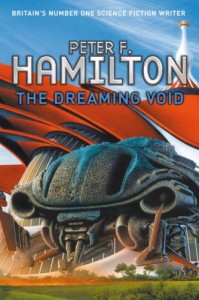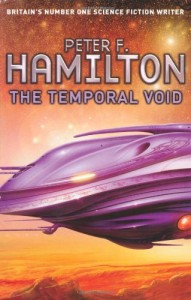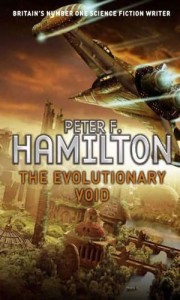 A novel in three volumes consisting of:
A novel in three volumes consisting of:
- The Dreaming Void
- The Temporal Void
- The Evolutionary Void
Like “Night’s Dawn” and the Commonwealth Saga before it, the “Void Trilogy” is not so much a series as one single novel, sprawling over three 1500 page volumes. That’s why it took two months to read. Set over one thousand years after the end of Commonwealth, it reintroduces many of the old familiar characters. While it can be read independently, I would highly recommend that you read Commonwealth first. The background is invaluable.
In the Commonwealth of the 3500s, humanity has split into many groups. Biggest is the split between Advancers, what one might think of as “old fashioned” humans, and Highers, who see their physical existence as a precursor to upload into the machine intelligence known as ANA. Among the Highers, there are several rival factions, from the Accelerators, who wish to speed up human evolution  towards the enigmatic goal of transcendence, to the conservative Conservatives. Into this mix is thrust the religion of the Living Dream, born out of the dreams that its founder Inigo had of events inside the Void, a vast, enigmatic and (mostly) impenetrable region in the center of the galaxy. Inigo has dreamed of the life of a man called Edeard in a mysterious city on a planet in the Void. In fact, Inigo’s dreams of Edeard’s life mark a major subplot in the novel, as we follow Edeard from country boy to refugee to city constable in the city of Makkathran. The goal of Living Dream is to start a pilgrimage into the Void and there reach “fulfillment”. The rest of humanity and most alien races are more or less united against it, believing that such a pilgrimage will lead to an expansion of the Void which will engulf the rest of the galaxy, terminating all life.
towards the enigmatic goal of transcendence, to the conservative Conservatives. Into this mix is thrust the religion of the Living Dream, born out of the dreams that its founder Inigo had of events inside the Void, a vast, enigmatic and (mostly) impenetrable region in the center of the galaxy. Inigo has dreamed of the life of a man called Edeard in a mysterious city on a planet in the Void. In fact, Inigo’s dreams of Edeard’s life mark a major subplot in the novel, as we follow Edeard from country boy to refugee to city constable in the city of Makkathran. The goal of Living Dream is to start a pilgrimage into the Void and there reach “fulfillment”. The rest of humanity and most alien races are more or less united against it, believing that such a pilgrimage will lead to an expansion of the Void which will engulf the rest of the galaxy, terminating all life.
As usual with Hamilton, the plot is complex, the characters are many, and the descriptions just lovely. The story is certainly gripping. However I did feel that this time, Mr. Hamilton didn’t quite grip me enough. Perhaps I now have too high expectations from him, but Void felt a bit ponderous, especially in the beginning. By contrast, the  interludes with Edeard were quite the story in themselves, almost able to stand on their own as a novel. Weird as it may seem, I felt as if the novel wasn’t quite long enough. Some bits were a bit too sketchy, such as the whole Ocisen attack subplot. Yes, it was just a device used by a faction, but even so the complexities were worth exploring further. There was also a bit of a lack of action for much of the novel. People went hither and thither in their starships but there was often precious little actual plot or character development. So I wanted the novel to be longer, but in parts it was too slow? Exactly! The ending, however, was quite gratifying. Hamilton has by his own admission, often had difficulties actually tying things up. But he did it nicely here.
interludes with Edeard were quite the story in themselves, almost able to stand on their own as a novel. Weird as it may seem, I felt as if the novel wasn’t quite long enough. Some bits were a bit too sketchy, such as the whole Ocisen attack subplot. Yes, it was just a device used by a faction, but even so the complexities were worth exploring further. There was also a bit of a lack of action for much of the novel. People went hither and thither in their starships but there was often precious little actual plot or character development. So I wanted the novel to be longer, but in parts it was too slow? Exactly! The ending, however, was quite gratifying. Hamilton has by his own admission, often had difficulties actually tying things up. But he did it nicely here.
So what’s the verdict? If you have read Commonwealth and enjoyed it, you can’t go wrong by continuing with Void. It is not as good as Night’s Dawn or Commonwealth, but Hamilton at his worst is better than most authors at their best. It is great space opera, and few can write it like he does.

Peter F. Hamilton – The Void Trilogy
Like “Night’s Dawn” and the “Commonwealth Saga” before it, the “Void Trilogy” is not so much a series as
one single novel, sprawling over three 1500 page volumes. Set over one thousand years after the end of
Commonwealth, it reintroduces many of the old familiar characters. While it can be read independently, I
would highly recommend that you read Commonwealth first. The background is invaluable.
In the Commonwealth of the 3500s, humanity has split into many groups. Biggest is the split between
Advancers, what one might think of as “old fashioned” humans, and Highers, who see their physical
existence as a precursor to upload into the machine intelligence known as ANA. Among the Highers, there
are several rival factions, from the Accelerators, who wish to speed up human evolution towards the
enigmatic goal of trancendence, to the conservative Conservatives. Into this mix is thrust the religion of
the Living Dream, born out of the dreams that its founder Inigo had of events inside the Void, a vast
enigmatic and impenetrable region in the center of the galaxy. Inigo has dreamt of the life of a man
called Edeard in a mysterious city on a planet in the Void. In fact, Inigo’s dreams of Edeard’s life mark
a major subplot in the novel, as we follow Edeard from country boy to refugee to city constable in the
city of Makkathran. The goal of Living Dream is to start a pilgrimage into the Void. The rest of humanity,
and most alien races, are more or less united against it, believing that such a pilgrimage will lead to an
expansion of the Void which will engulf the rest of the galaxy, terminating all life.
As usual with Hamilton, the plot is complex, the characters are many, and the descriptions just lovely.
The story is certainly gripping. However I did feel that this time, Mr. Hamilton didn’t quite grip me
enough. Perhaps I now have too high expectations from him, but Void felt a bit ponderous, especially in
the beginning. By contrast, the interludes with Edeard were quite the story in themselves, almost able to
stand on their own as a novel. Weird as it may seem, I felt as if the novel wasn’t quite long enough. Some
bits were a bit too sketchy, such as the whole Ocisen attack subplot. Yes, it was just a device used by a
faction, but even so the complexities were worth exploring further. There was also a bit of a lack of
action for much of the novel. People went hither and thither in their starships but there was often
previous little actual plot or character development. So I wanted the novel to be longer, but in parts it
was too slow? Exactly! The ending, however, was quite gratifying. Hamilton has by his own admission, often
had difficulties actually tying things up. But he did it nicely here.
So what’s the verdict? Well, if you have read Commonwealth and enjoyed it, you can’t go wrong by
continuing with Void. It is not as good as Night’s Dawn or Commonwealth, but Hamilton at his worst is
better than most authors at their best. It is certainly great space opera, and few can write it like he
does. 20101123
 Two hundred and fifty years after the events in The Abyss Beyond Dreams, Bienvenido society has been profoundly changed. The planet has been exiled from the Void to a star system outside any galaxy, perhaps because the inhabitants “misbehaved”. It orbits the lonely star together with a scattering of other planets with a similar fate, some with extant species, others sterile. After Slvasta’s revolution, society follows an oppressive model similar to Stalinism. The state rules and the secret police is its enforcer, feared by all, but mostly by “Eliters”, those who have working macrocellular clusters, stemming from certain genetic traits inherited from the Commonwealth thousands of years previously. The Eliters are downtrodden but defiant. Bienvenido is still under attack by the Faller trees, now slowly being chipped away at by regular space missions to destroy them one by one with nuclear bombs.
Two hundred and fifty years after the events in The Abyss Beyond Dreams, Bienvenido society has been profoundly changed. The planet has been exiled from the Void to a star system outside any galaxy, perhaps because the inhabitants “misbehaved”. It orbits the lonely star together with a scattering of other planets with a similar fate, some with extant species, others sterile. After Slvasta’s revolution, society follows an oppressive model similar to Stalinism. The state rules and the secret police is its enforcer, feared by all, but mostly by “Eliters”, those who have working macrocellular clusters, stemming from certain genetic traits inherited from the Commonwealth thousands of years previously. The Eliters are downtrodden but defiant. Bienvenido is still under attack by the Faller trees, now slowly being chipped away at by regular space missions to destroy them one by one with nuclear bombs.











